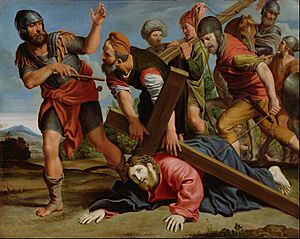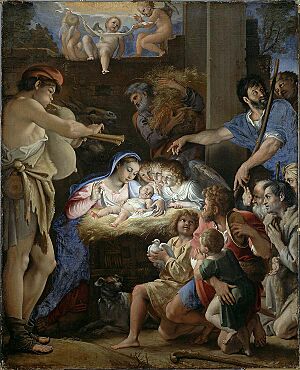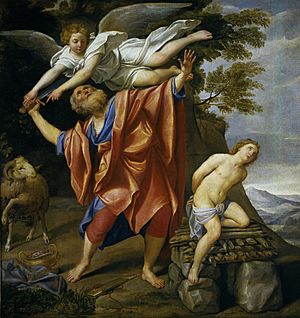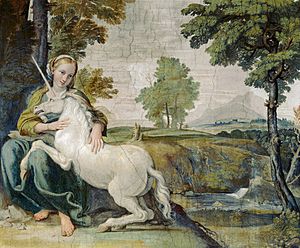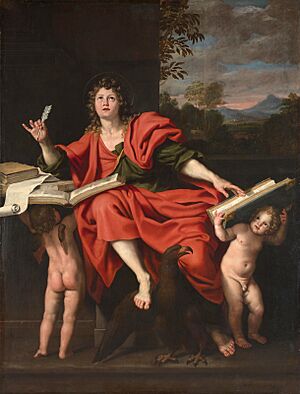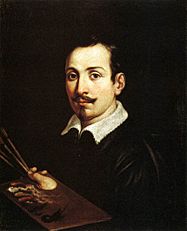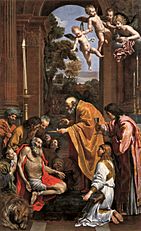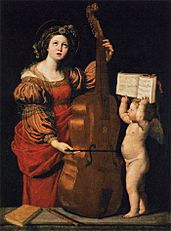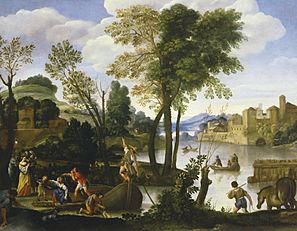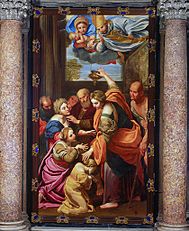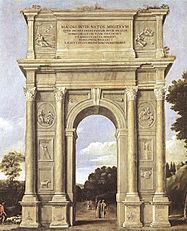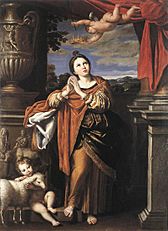Domenichino facts for kids
Quick facts for kids
Domenichino
|
|
|---|---|
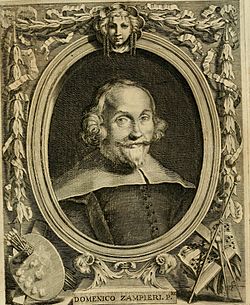
Domenichino, in a portrait by an unknown artist
|
|
| Born |
Domenico Zampieri
October 21, 1581 |
| Died | April 6, 1641 (aged 59) Naples, Kingdom of Naples
|
| Nationality | Italian |
| Known for | Painting |
| Movement | Baroque |
Domenico Zampieri (born October 21, 1581 – died April 6, 1641), known as Domenichino, was a famous Italian Baroque painter. His nickname, Domenichino, means "little Domenico" in Italian. He was part of the Bolognese School of painters.
Contents
Life of Domenichino
Domenichino was born in Bologna. His father was a shoemaker. He first studied painting with Denis Calvaert. After some disagreements, he joined the Carracci family's art school, the Accademia degli Incamminati. Because he was short, people started calling him Domenichino.
In 1602, he moved to Rome. There, he became one of the best students of Annibale Carracci. He lived with other artists from Bologna, like Francesco Albani and Guido Reni. He also worked alongside Giovanni Lanfranco, who later became his main rival.
Early Works in Rome
Domenichino helped Annibale Carracci paint frescoes in the Galleria Farnese. He also created his own frescoes in the Palazzo Farnese, Rome around 1603–1604. With support from important church leaders, he received more painting jobs in Rome.
One of his first big projects was decorating the Abbey of Grottaferrata from 1608 to 1610. He also painted frescoes in other churches and palaces. For example, he painted The Flagellation of St. Andrew at San Gregorio Magno. This painting was a competition with a fresco by Guido Reni.
After Annibale Carracci died in 1609, Domenichino and other students struggled to get the most important jobs. Guido Reni often received better commissions and pay. Domenichino sometimes had to work hard to find jobs and accept lower fees.
Masterpieces and Later Career
One of Domenichino's most famous works is the frescoes showing Scenes of the Life of Saint Cecilia. He painted these in the Polet Chapel of San Luigi dei Francesi between 1612 and 1615. At the same time, he painted his most celebrated altarpiece, The Last Communion of St. Jerome (1614). Many people thought this painting was as good as, or even better than, famous works by Raphael.
Around 1616, Domenichino designed a ceiling painting for Santa Maria in Trastevere. He also started a series of ten frescoes about the Life of Apollo in Frascati. He worked with Giovanni Battista Viola, who helped develop landscape painting. From 1617 to 1621, Domenichino left Rome to work in Bologna and Fano. There, he frescoed the Nolfi chapel in Fano Cathedral.
When a pope from Bologna (Pope Gregory XV) was elected in 1621, Domenichino returned to Rome. He became the Papal Architect, though he mostly focused on painting. He received many commissions for altarpieces in Roman churches. He also painted many frescoes in the 1620s, including in Sant'Andrea della Valle. Here, he had a strong rivalry with Lanfranco, who painted the dome above Domenichino's work.
Move to Naples and Death
In 1631, Domenichino moved to Naples for a very important and well-paying job. He was to decorate the Royal Chapel of the Treasure of San Gennaro in the Naples Cathedral. He spent the rest of his life painting Scenes from the Life of San Gennaro. He painted large frescoes and three altarpieces.
Domenichino died in Naples in 1641. He passed away before finishing all his work in the chapel. Some people believed he might have been poisoned by jealous rivals. After his death, Lanfranco finished the dome he had started.
Many artists studied with Domenichino. These included Nicolas Poussin and Pietro Testa.
Ideas on Art
Domenichino's art was inspired by Raphael and the Carracci family. He worked with his friend Giovanni Battista Agucchi on a book about painting. Their ideas were about creating "classic-idealist art." This type of art aimed to improve on nature by finding an "Idea of Beauty." Artists would study and learn from the best ancient and Renaissance art. This was not just copying, but a creative process to make art even better.
One famous event involved Domenichino's painting, Last Communion of St. Jerome. Another artist, Lanfranco, accused Domenichino of copying his former teacher, Agostino Carracci. However, many artists and critics, including Poussin, defended Domenichino. They said his work was a good example of "praiseworthy imitation," meaning he was inspired by and improved upon earlier works.
Domenichino also loved music. He was interested in creating new musical instruments. Like his paintings, his music aimed for clear expression to move the audience. He believed artists should "move the passion of the mind." To do this, he paid close attention to how people's gestures could show emotion.
He made about 1750 drawings, which show how much he studied his subjects. These drawings include figures, buildings, landscapes, and even funny pictures. An art critic named Roger de Piles in 1708 rated artists in different categories. Domenichino scored very high for his drawing and expression. This shows how highly he was thought of in Europe for a long time.
Later Criticism and Appreciation
Domenichino's high reputation lasted until the 1840s. Then, John Ruskin, a famous art critic, strongly criticized Bolognese Baroque painting. Ruskin called the Carracci and their followers "insincere." He believed there was no truly great art in the 17th century.
However, modern art experts have brought Domenichino's work back into favor. They have shown his importance among the great painters of 17th-century Italy. In 1996, the first major exhibition of his work was held in Rome.
Selected Works
- Saint John the Evangelist, 1621–1629
- The Virgin, Infant Jesus, and John the Baptist (The Madonna of Silence), around 1605
- A Virgin with a Unicorn, around 1604–05, a fresco in Palazzo Farnese, Rome
- Abraham Leading Isaac to Sacrifice, 1602
- Landscape with Baptism of Christ, around 1603
- Landscape with Flight into Egypt, around 1605–06
- Portrait of Cardinal Girolamo Agucchi, around 1604–05
- Adoration of the Shepherds, around 1607–1610
- Flagellation of St. Andrew, 1609
- The Ascension of St. Paul, around 1606–1608
- Scenes from the Life of Diana, 1609
- The 'Consecratio' of a Roman Emperor, 1634–1636
- Cumaean Sybil, around 1610
- Way to Calvary, around 1610
- Last Communion of St Jerome, 1614
- Scenes of the Life of Saint Cecilia, 1612–1615, frescoes
- Landscape with St Jerome, around 1610
- Cumaean Sybil, 1616–17
- Madonna of the Rosary, 1617–1625
- Archery Contest of Diana and her Nymphs, around 1616–17
- The Virgin and Child with Saints John the Baptist and Petronius, 1626–1629
- Saint Agnes, around 1620
- Rinaldo and Armida, around 1620–21
- Life of Apollo, 1616–18, frescoes
- The Four Evangelists and Scenes from the Life of St. Andrew, 1622–1627, frescoes
- Landscape with Hercules and Acheloüs, around 1622–23
- Saint Ignatius de Loyola's Vision of Christ and God the Father, around 1622
- Rebuke of Adam and Eve, around 1623–1625
- An Allegory of Agriculture, Astronomy and Architecture, around 1624–25
- Martyrdom of St. Agnes, around 1619–1625
- Martyrdom of St Sebastian, 1625–1630
- Assumption of the Virgin, 1616–17
- Saint Cecilia with an Angel, around 1617–18
- Sacrifice of Isaac, around 1627–28
- Scenes from the Life of San Gennaro, 1631–1641, frescoes
- Landscape with Tobias laying hold of the Fish, around 1610–1612
- Mary Magdalene in Glory, around 1620
- Sibyl, 17th century
- The Appearance of the Angels to St. Jerome
- The Head of the Baptist
- St. John the Evangelist, around 1625-1628
Works
See also
 In Spanish: Domenichino para niños
In Spanish: Domenichino para niños


